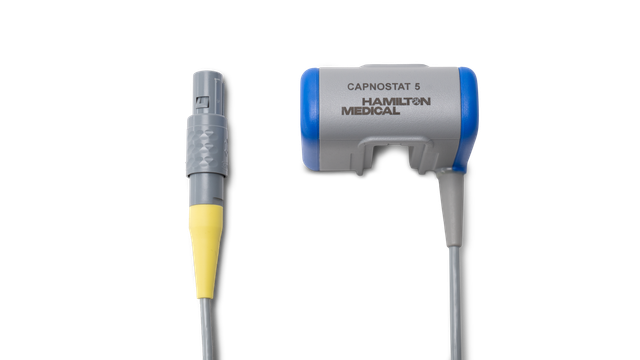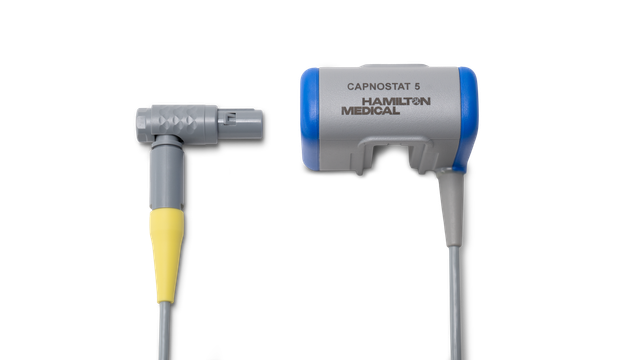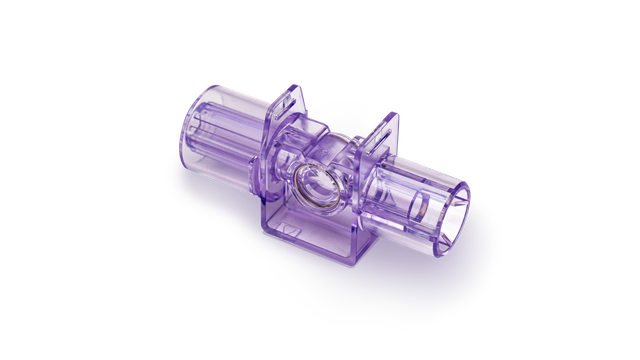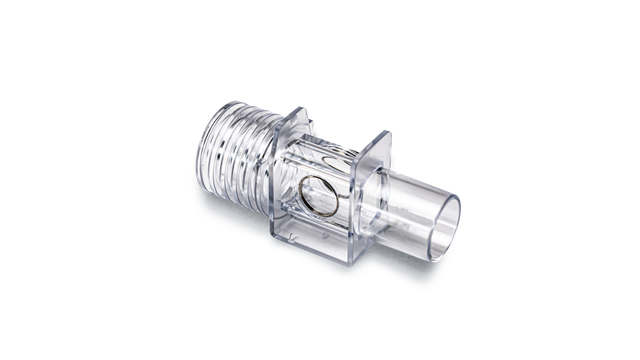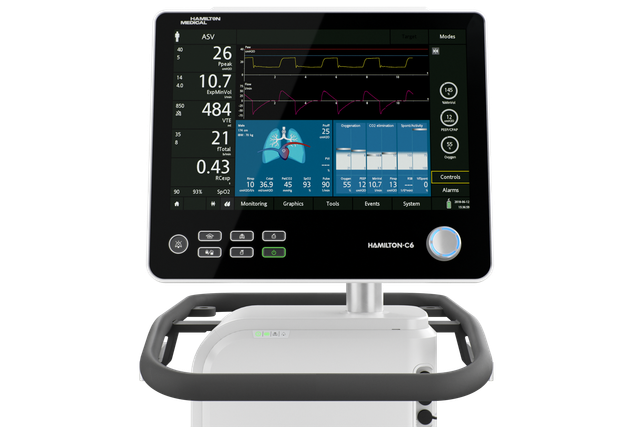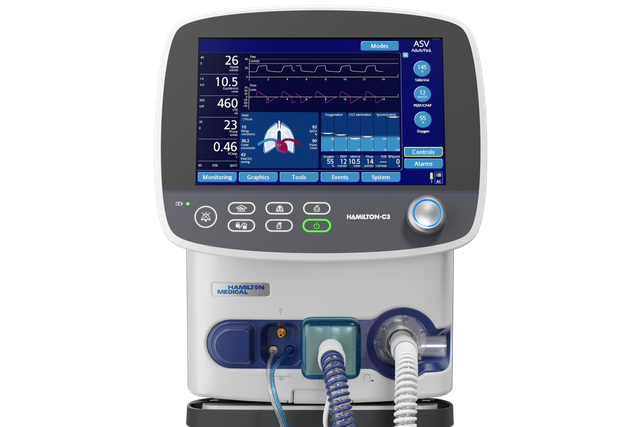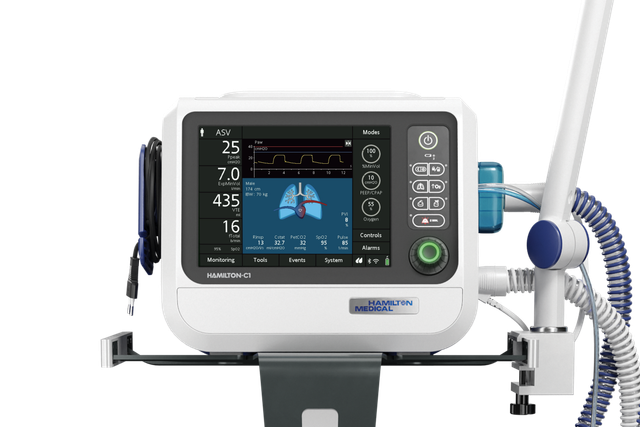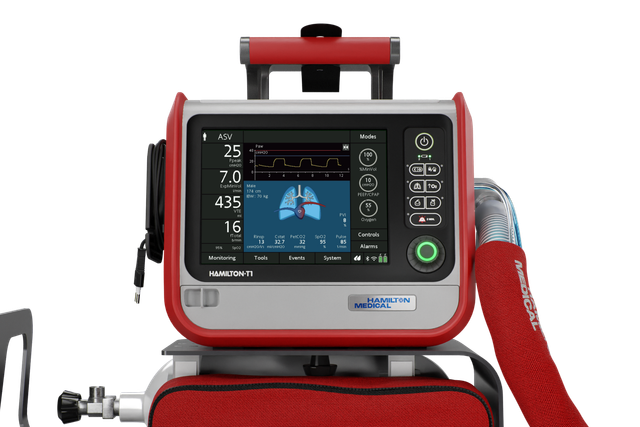
Pour plus d'informations. Monitorage volumétrique du CO2
Les phases d'un capnogramme volumétrique, la forme et la morphologie de la courbe, ainsi que les mesures basées sur les calculs qui en découlent peuvent vous en apprendre beaucoup sur :
- L'efficacité de la ventilation‑perfusion
- La fraction d'espace mort physiologique
- L'activité métabolique du patient (
Jaffe MB. Using the features of the time and volumetric capnogram for classification and prediction. J Clin Monit Comput. 2017;31(1):19‑41. doi:10.1007/s10877‑016‑9830‑z1 )
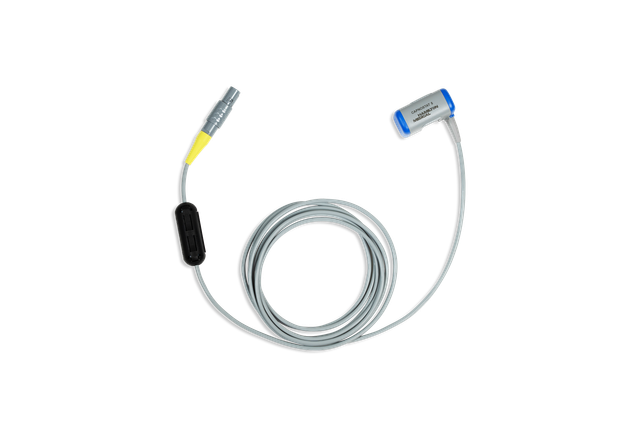
Un outil puissant. Le capteur de CO2
Sur nos ventilateurs, le CO2 est mesuré avec un capteur de CO2 « mainstream » CAPNOSTAT‑5 près des voies aériennes du patient.
Le capteur CAPNOSTAT‑5 fournit une mesure précise du dioxyde de carbone en fin d'expiration (PetCO2) et un capnogramme précis et clair à toutes les fréquences respiratoires jusqu'à 150 cycles par minute.
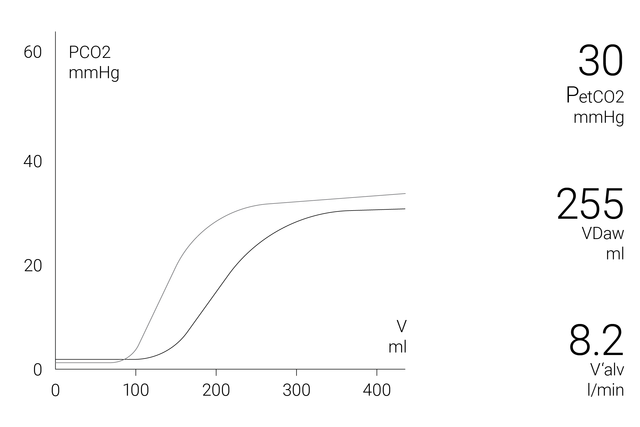
Un petit capteur pour un maximum de données. Les infos qu'il vous faut
La fenêtre du capnogramme volumétrique apparaissant à l'écran affiche des informations quantitatives exactes sous forme d'une combinaison de données de débit proximal et de CO2 proximal telles que :
- Courbe de capnogramme volumétrique réel
- Courbe de capnogramme volumétrique de référence
- Bouton de courbe de référence avec date et heure de la boucle de référence
- Valeurs de CO2 les plus pertinentes, mises à jour à chaque cycle
Pour permettre une analyse plus détaillée de l'état du patient, une tendance sur 72 heures (ou sur 96 heures avec le HAMILTON‑G5/S1) est disponible pour les valeurs suivantes :
- PetCO2
- V‘CO2
- FetCO2
- VeCO2
- ViCO2
- Valv
- V'alv
- Vds
- VD/Vt
- Vds/VTE
- PenteCO2
Pour vous faciliter la vie, les ventilateurs Hamilton Medical affichent une présentation de toutes les valeurs pertinentes associées au CO2 dans la fenêtre de monitorage du CO2.
- Concentration fractionnelle de CO2 de fin d'expiration : FetCO2 (%)
- Pression de CO2 de fin d'expiration : PetCO2 (mmHg)
- Pente du plateau alvéolaire sur la courbe PetCO2, indiquant le statut volume/débit des poumons : penteCO2 (%CO2/l)
- Ventilation alvéolaire par volume courant : Valv (ml)
- Ventilation alvéolaire minute : V’alv (l/min)
- Élimination du CO2 : V’CO2 (ml/min)
- Espace mort des voies aériennes : Vds (ml)
- Fraction d'espace mort mesurée à l'entrée des voies aériennes : Vds/VTE (%)
- Volume de CO2 expiré : VeCO2 (ml)
- Volume de CO2 inspiré : ViCO2 (ml)
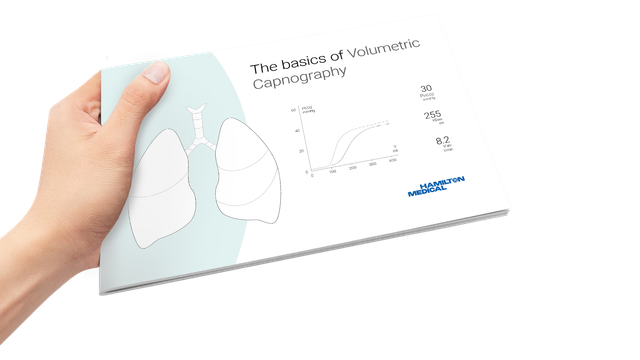
E‑book gratuit
Bon à savoir ! Tout sur la capnographie volumétrique
Apprenez à interpréter un capnogramme volumétrique et découvrez les avantages et les applications cliniques de la capnographie volumétrique. Inclut un auto‑test !
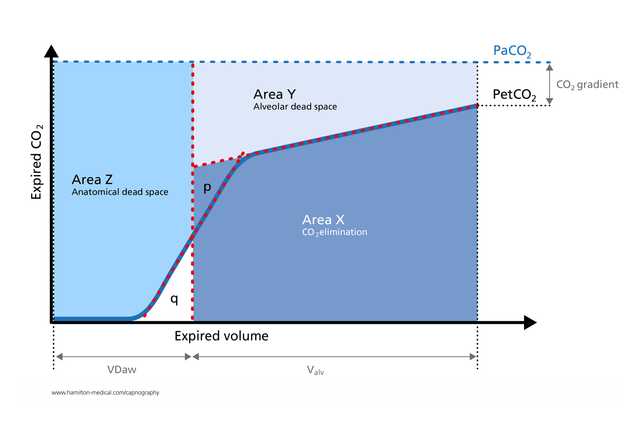
Quels sont les avantages ? Focus sur les preuves de réussite
Le capnogramme volumétrique a été utilisé avec succès pour mesurer l'espace mort anatomique, la perfusion des capillaires pulmonaires et l'efficacité du ventilateur (
Romero PV, Lucangelo U, Lopez Aguilar J, Fernandez R, Blanch L. Physiologically based indices of volumetric capnography in patients receiving mechanical ventilation. Eur Respir J. 1997;10(6):1309‑1315. doi:10.1183/09031936.97.100613092 )Les calculs obtenus à partir de la capnographie volumétrique sont utiles pour identifier une embolie pulmonaire au chevet du patient (
Blanch L, Romero PV, Lucangelo U. Volumetric capnography in the mechanically ventilated patient. Minerva Anestesiol. 2006;72(6):577‑585. 3 )Dans une étude portant sur des patients souffrant de SDRA et ventilés mécaniquement, les mesures de capnographie volumétrique du ratio espace mort/volume courant physiologique étaient aussi précises que celles obtenues via la technique du monitorage métabolique (
Kallet RH, Daniel BM, Garcia O, Matthay MA. Accuracy of physiologic dead space measurements in patients with acute respiratory distress syndrome using volumetric capnography: comparison with the metabolic monitor method. Respir Care. 2005;50(4):462‑467. 4 )Le capnogramme expiratoire est une mesure non invasive, rapide et indépendante des efforts qui permet de détecter des bronchospasmes importants chez des patients adultes souffrant d'asthme (
Yaron M, Padyk P, Hutsinpiller M, Cairns CB. Utility of the expiratory capnogram in the assessment of bronchospasm. Ann Emerg Med. 1996;28(4):403‑407. doi:10.1016/s0196‑0644(96)70005‑75 )En fournissant des données précieuses en temps réel sur la physiologie de l'affaissement et du recrutement pulmonaires de manière non invasive, la capnographie volumétrique se prête elle‑même au monitorage de manœuvres de recrutement cycliques au chevet du patient (
Tusman G, Suarez-Sipmann F, Böhm SH, et al. Monitoring dead space during recruitment and PEEP titration in an experimental model. Intensive Care Med. 2006;32(11):1863-1871. doi:10.1007/s00134-006-0371-76 )

Bon à savoir ! Supports de formation sur la capnographie volumétrique
Accessoires et consommables
Nous proposons des consommables d'origine pour patients adultes, enfants et nouveau‑nés. Vous avez le choix entre des produits réutilisables ou à usage unique, en fonction de la politique en vigueur dans votre établissement.
Disponibilité
La capnographie volumétrique est disponible en option sur les ventilateurs HAMILTON‑C6, HAMILTON‑G5, HAMILTON‑C3, HAMILTON‑C1/T1 et en fonctionnalité standard sur le HAMILTON‑S1.
Références
- 1. Jaffe MB. Using the features of the time and volumetric capnogram for classification and prediction. J Clin Monit Comput. 2017;31(1):19‑41. doi:10.1007/s10877‑016‑9830‑z
- 2. Romero PV, Lucangelo U, Lopez Aguilar J, Fernandez R, Blanch L. Physiologically based indices of volumetric capnography in patients receiving mechanical ventilation. Eur Respir J. 1997;10(6):1309‑1315. doi:10.1183/09031936.97.10061309
- 3. Blanch L, Romero PV, Lucangelo U. Volumetric capnography in the mechanically ventilated patient. Minerva Anestesiol. 2006;72(6):577‑585.
- 4. Kallet RH, Daniel BM, Garcia O, Matthay MA. Accuracy of physiologic dead space measurements in patients with acute respiratory distress syndrome using volumetric capnography: comparison with the metabolic monitor method. Respir Care. 2005;50(4):462‑467.
- 5. Yaron M, Padyk P, Hutsinpiller M, Cairns CB. Utility of the expiratory capnogram in the assessment of bronchospasm. Ann Emerg Med. 1996;28(4):403‑407. doi:10.1016/s0196‑0644(96)70005‑7
- 6. Tusman G, Suarez‑Sipmann F, Böhm SH, et al. Monitoring dead space during recruitment and PEEP titration in an experimental model. Intensive Care Med. 2006;32(11):1863‑1871. doi:10.1007/s00134‑006‑0371‑7


